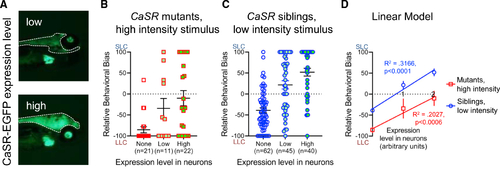Fig. 4
- ID
- ZDB-FIG-230511-49
- Publication
- Shoenhard et al., 2022 - The calcium-sensing receptor (CaSR) regulates zebrafish sensorimotor decision making via a genetically defined cluster of hindbrain neurons
- Other Figures
- All Figure Page
- Back to All Figure Page
|
Neuronal CaSR expression shifts decision making in CaSR mutants and siblings in a dose-dependent manner
(A) Brains and rostral spinal cords of larvae expressing CaSR-EGFP under control of the αTub:Gal4 driver, outlined with white dashed line. Since the αtubulin:Gal4 line also includes a myl7:GFP marker, green hearts are also visible. Top, representative example of a fish from the “low expression” category. Bottom, representative example of a fish from the “high expression” category. (B) Relative behavioral bias in response to strong acoustic stimuli of CaSR mutants not expressing any CaSR-EGFP (no fill), manually sorted into the “low expression” category (light green fill), or manually sorted into the “high expression” category (bright green fill). Lines represent means +/− SEM. (C) Relative behavioral bias in response to weak acoustic stimuli of CaSR siblings not expressing any CaSR-EGFP (no fill), manually sorted into the “low expression” category (light green fill), or manually sorted into the “high expression” category (bright green fill). Lines represent means +/− SEM. (D) Univariate linear models of effects of CaSR-EGFP expression levels in neurons on relative behavioral bias. For the X axis, arbitrary units were used, with 0 corresponding to no CaSR-EGFP expression, 1 to low CaSR-EGFP expression, and 2 to high CaSR-EGFP expression. Red squares, CaSR mutants (from B). Blue circles, CaSR siblings (from C). Mutant linear model slope significantly different from 0, p = 0.0006; R2 = 0.2027. Sibling linear model slope significantly different from 0, p < 0.0001; R2 = 0.3166. |

